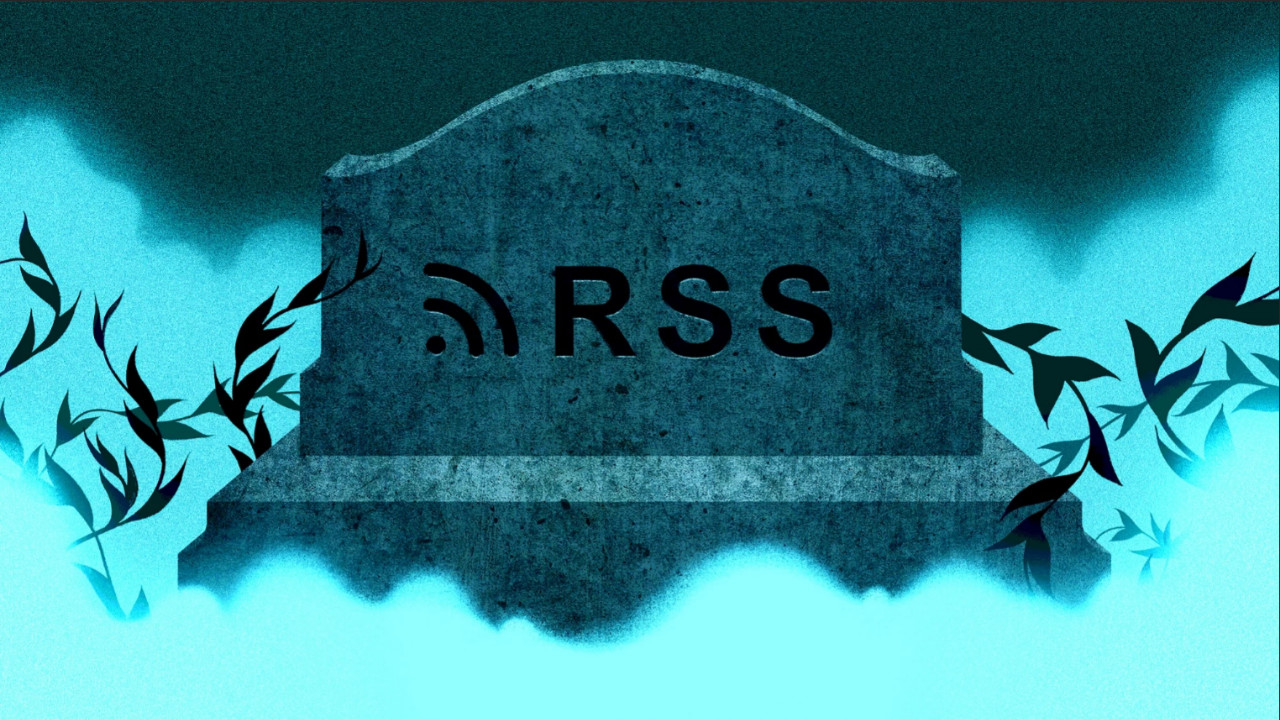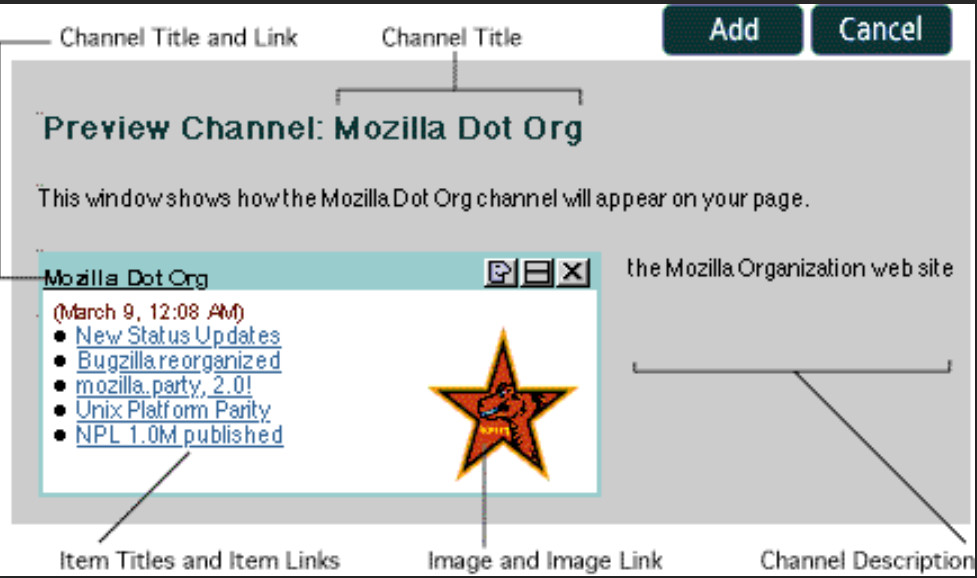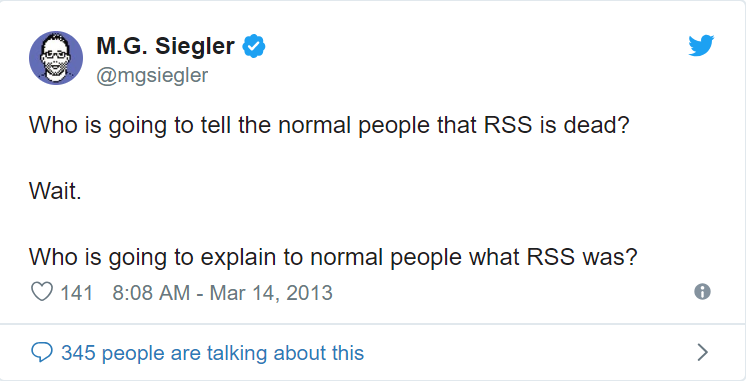RSS lost to social networks, what enlightenment does it have for the blockchain? | Web3.0 Recommended Notes
Author: Sinclair
Compilation of the original text: Yao Changlin
This article is from the WeChat public account Orange Book, reprinted and edited by Odaily with authorization.

The older generation of Internet people should be very touched when reading this article, and the new generation of blockchain will also see many familiar phenomena. Huo Ju, a player with both identities, feels more complicated. He recommends this article in this way:
"By the time of 2019, looking back at the history of the emergence and decline of RSS can clearly see the gains and losses. This article fully describes the rise of RSS in 1999 to the closure of Google reader in 2013, content reading and distribution by social networks Replaced by the full history.
The reason why this article is recommended is that this history has many similarities with the blockchain. Compared with today's social networks, RSS is a more distributed, more equal, and more open system, but it was eventually defeated up. One of the important reasons is that centralized products are easier to design, provide a better experience, and are easier for users to understand without having to learn complex concepts, providing a better way to make money for operating companies.
The same is true of the comparison between blockchain and centralized products today. This time, can decentralized products take a different path? "
This article is a bit long, and there are many uncommon and ancient English technical vocabulary. Fortunately, it doesn't matter if you don't understand the technical details. In addition, there are many English names in it. We changed a few important names into Chinese. When they appear for the first time, they will be marked in red. Remember these people so that you will not get lost.
More than ten years old netizens should be familiar with RSS. In fact, RSS has two different definitions, Really Simple Syndication and Rich Site Summary, but they are essentially a program-friendly information subscription method. There are still applications and websites using RSS technology today, but for most users, RSS has become a vague concept.
Looking back at the history of RSS, there are two stories worth telling: the first is a great vision for the future of the web that never materialized; Controversial split.
In the late 1990s, the fantastic decade between the Netscape IPO and the dot com bubble, no one knew where the internet was going to go, but everyone realized that the internet would be more imaginative than it is now. There is a speculation that the internet will be revolutionized by the "converged network". The original Internet is a point-to-point transmission, which transmits information from the server to the user in one direction, but the new model may break the original structure and repackage and distribute the entire network information in the form of "channels".
At that time, there was an influential Newsletter among the investor community called Releas 1.0. Werbach predicted in an article: "The aggregation network will evolve into the core model of the Internet ecology, and companies and individuals can control their own Online identities can also enjoy the benefits of the vast network."
The future of RSS was so bright, what happened?
Weibach asked readers to imagine such a scene: a fencing enthusiast has two options when buying an epee, one is to log in to the e-commerce website or go to an offline store, and the other is to log in to the fencing website every day and click on the advertisement column on the right can be purchased. Similar to the radio and television network, the programs of big TV stations can be broadcast on local small TV stations, so that more people will watch them. Aggregation networks can provide information to users through intermediary websites. In this way, users can more easily control their information interaction with the Internet.
RSS is one of the most promising standards for this syndicated future. Weibach sees RSS as "the poster child for a lightweight syndication protocol." Another contemporary article argued that RSS was the first protocol to realize the potential of XML (Extensible Markup Language). RSS can help readers and content aggregators customize channels from their desired sites.
But today, 20 years later, with the rise of social networks, Google closed Google Reader, RSS is only used in podcasts, technical podcasts and some news sources, and has become a technology that is slowly dying. Indeed, there are still many people who rely on RSS readers and stubbornly add RSS to blogs as a kind of sentiment. These insistences turned into a protest against the centralized network, a protest against a few large companies that control the entire network, against a network that is completely different from Weibach's imagination.
The future of RSS was so bright, what happened? Is the collapse of RSS inevitable? Could it really be caused by infighting over standards?
bogged down
RSS was invented twice, meaning it didn't have a single recognized inventor and would be subject to endless bickering. But it also shows that RSS is a good idea at the right time.
In 1998, Netscape was looking for the next user increase. Its flagship product "Netscape Browser" once occupied 80% of the market share, and now the market share is quickly eroded by Microsoft's IE browser. So Netscape needed a new project. In May, Netscape assembled a team to work on a new project, "Project 60," based on the RSS news tool developed by Ben Hammersle's Atom project. Two months later Netscape released a new portal product "My Netscape" to compete with portals such as Yahoo, MSN, and Excite.
In March of the following year, Netscape added a new feature "My Netscape Network" to the portal My Netscape. Users can customize My Netscape pages, add channel features, and subscribe to the latest headlines from other sites. As long as the website publishes files in a "specified format", users can click "Add Channel" to subscribe to their favorite websites on their My Netscape homepage. A module containing the headlines of the site, where the user's My Netscape page appears.

This "specified format" file is the RSS file. But in the statement of My Netscape Network, Netscape defines RSS as "RDF Site Summary (RDF site summary)". In fact, this definition is not precise enough, because RDF (Resource Description Framework) is a syntax for describing specific attributes of specified resources.
In fact, W3C also planned to draft RDF standards in 1999. Although RSS should theoretically be based on RDF, the RSS reference document given by Netscape does not use any RDF tags at all. In the Netscape RSS specification document, its author Dan Libby mentioned that Netscape deliberately limited the complexity of RSS in the MNN version. The version number of this specification is set as 0.90, which means that subsequent versions will be more consistent with W3C standards.
The original RSS standard was developed by Libby and Netscape colleagues Eckart Walther and Ramanathan Guha. Guha's e-mail mentioned that the ideas developed by Guha and Walther came largely from Libby's early ideas; after AOL's acquisition of Netscape, they both left, and Libby undertook the main update work. Guha has made a lot of contributions to the development of RDF, and he and Walther plan to apply RDF to RSS. Later, Libby mentioned in the email that the RDF version of RSS was finally deleted for two reasons: the first is time constraints, and the second is that RDF is too complicated for ordinary users.
While Netscape was locked in a "portal war" trying to win traffic, "web blogging" quietly took off. The CEO of UserLand software company, Winer, invented the earliest content management system, so that ordinary people who do not understand technology can also build their own blogs. Weiner's blog, Scripting News, is one of the oldest blogs on the Internet. More than a year before Netscape released My Netscape Network, on December 15, 199, Weiner announced that its blog product would support both XML and HTML formats.
Wiener's XML format is called the "scripted news format." It has been suggested that it is similar to Microsoft's channel definition format, but there is no documented evidence. Like Netscape's RSS, Wiener defines the structure of the text, which is convenient for other programs to read and call. When Netscape released RSS version 0.90, UserLand announced support for both formats. But Weiner felt that Netscape's version was "lamentably incomplete" and "missing the core parts that authors and readers most need". It can only quote a series of links, while the "scripted news format" can contain more content: it contains more paragraphs, and each paragraph can have many links.
In June 1999, two months after Netscape released My Netscape Network, Wiener also released a new version of the "scripted news format" -- ScriptingNews 2.0b1. Wiener Accelerated continued to promote its own standard, and users did not realize the huge flaws of RSS 0.90. Wiener's version adds some new elements and is compatible with RSS. But there's one big difference between the two standards: What Wiener calls a "fat" format can contain entire articles, not just links.
In July, Netscape will release RSS 0.91, and a major problem is to update the text specification. RSS no longer stands for "RDF Site Summary", but "Rich Site Summary". All RDF elements are removed. A lot of scripted news tags have also been merged. In this text specification, Libby explains:
RDF references have been removed from the standard. RSS, including RDF, is a metadata format for website summaries. Deletion has two important considerations. First of all, the data side needs to provide an aggregated data format, not a metadata format, and the RDF file must be very accurate to meet the standard. But this will cause difficulty in reading, and it is difficult to directly develop RDF files manually. Second, there are no tools to generate RDF files. Based on the above two points, we decided to adopt the standard XML approach.
Wiener was very pleased with RSS 0.91, declaring it "better than I thought it would be," as a replacement for the ScriptingNews 2.0b1 format. At one time, everyone believed that RSS would soon have a unified official version.
big split
After 1 year, everyone found that RSS 0.91 had many shortcomings. Version 0.91 can't do a lot of things that people want to do with RSS, and there are a lot of redundant restrictions, such as a maximum of 15 links per channel.
At this time, RSS technology has been widely used. Netscape has no interest in RSS 0.91, and most other companies are using Wiener's standard, such as O'Reilly Net's RSS aggregator Meerkat, news aggregation website Moreover.com, etc. Representatives of various interested parties exchanged emails on how to improve the 0.91 standard, but no consensus has been reached.
A disagreement over namespaces is a disagreement over the nature of RSS
A collection of emails called Syndication, which records all emails discussing the RSS standard, is still available today. Still precious history today, documenting how these deep divisions ultimately tore the entire RSS community apart.
The representative of the split is Wiener. He was keen to improve RSS, but iteratively in a relatively conservative way. In June 2000, Wiener released version 0.91, but it is actually not much different from Netscape's version. Weiner said in his blog that since Netscape is no longer maintaining updates, 0.91 is used as a starting point to show how RSS can be used in practical scenarios.
At the same time, he also believes that the simple and easy-to-use RSS has been successful enough; the complex new features mentioned in the Syndication email will not provide any value for content distribution. In particular, he opposed the addition of namespaces (namespace), and also refused to restore the deleted form of RDF (namespaces allow programmers to customize subformats of RSS, which means that new features need to be agreed by everyone. But namespaces also allow RSS to read and writing is more difficult). In the Syndication mailing group, Weiner mentioned that these changes are very important and may cause a split in the standard:
We are still thinking about how to advance the development of RSS. Of course, I also want to use ICE-like content in RSS2, and the publishing and subscribing functions are also a high priority, but the premise of everything is simple. I also want more room for expansion, but I will never use "namespaces", "schema" or repeat the old way of RDF. I understand that there may still be people who need to keep these features, so there may be a new forked version. I have a lot of ideas about the forked version, and I will announce it to everyone when the time is right.
The other party against Weiner is mainly three people, Rael Dornfest of O'Reilly, Ian Davis, CEO of search startup Calab, and 14-year-old Aaron Swartz. Swartz is the co-founder of the familiar Reddit, a famous hacktivist. According to an email Davis sent me, in 2000, Swartz's father often accompanied him to attend technical conferences.
All three agree that RSS needs namespace capabilities to meet the different needs of users. In several other emails, Davis suggested building a namespace-based module that would make RSS more scalable and less complex. The pro-namespace camp argues that RSS will soon be used not only for synchronizing blogs, but for many other uses as well. On the premise of not increasing the complexity, the namespace is the only solution.
The controversy about the namespace is just an appearance, and the core of the controversy is "what should RSS be used for?". Weiner started his standard to sync his own blog. And Netscape released the RSS standard to build microsites in portal websites. Some people think that Netscape's original intention should be respected. In the email to Syndication, Davis mentioned that RSS was originally intended to build a "mini site map", but there have been many new demands in the past year, and RSS should now expand to support more types of information, not just simple news title.
This expanded Netscape's plans for RSS. Libby mentioned in an email to me that the debate on the development of RSS focused on: "building a global semantic web" VS "making it easier for people to publish their own works".
Weiner mentioned another completely different logic in his reply to Davis's email: Scripting News was the first RSS network, and its purpose was completely different from Netscape. The community was divided about RSS's inventor and its goals, and splits were inevitable.
The version split occurred after Donne announced the RSS 1.0 specification and formed the RSS-DEV working group (the working group included Davis, Swartz, etc., but no Weiner). In this 1.0 release, RSS is again defined as"RDF Site Summary", the RDF element is added again. Considering Wiener's contribution to RSS transmission in history, version 1.0 did not delete Wiener's name. But version 1.0 also mentions that RSS will not develop along the path planned by Wiener. Simply adding some elements to RSS without considering scalability, RSS will lose many application scenarios. Version 1.0 also defines a module system based on XML namespaces.
Wiener was outraged that RSS-DEV had arbitrarily called "RSS 1.0." In another email, he mentioned that a huge work of his has been stolen, probably referring to O'Reilly and its RSS-DEV working group.
Others on the mailing list also felt that the RSS-DEV working group should not use the name RSS without the consent of the community. But the working group still insists on using it. Dan Brickley, a member of the working group, argued that RSS1.0 is based on the earliest vision of RSS, which can be traced back to MCR (the predecessor of RDF) and CDF. He also believes that RDF is originally a part of RSS, and version 1.0 has contributed far more to RSS than Wiener, and is more worthy of the name RSS.
The RSS-DEV working group released the final version in December. Almost at the same time, Wiener released his own upgrade to RSS 0.91, RSS 0.92, and several changes in the upgraded version were quickly adopted by various podcasters. At this point, RSS officially split.
This split might have been avoided if the RSS-DEV working group had seriously invited Wiener to join. Weiner is obviously important, and the working group also recognizes him as the main author of Syndication, which has made important contributions to the popularization of RSS. But Davis’s email also mentioned that Weiner wanted to control RSS and turn RSS into private property, so he was unwilling to work with us. Wiener declined the invitation to the task force. O'Reilly CEO Tim O'Reilly explained at a UserLand seminar in September 2000:
Everyone gathered to discuss the evolution of RSS, and Wiener was there. When the opinions of those present turned in a direction he did not support, Weiner withdrew, saying that O'Reilly wanted to take his place through discussion, even though O'Reilly's Donne was only one of a dozen authors, and Donne had gone through The full history of RSS development.
Weiner wrote back to Tim O'Reilly:
I had just met Dale two weeks before the meeting, and he hadn't mentioned RSS 1.0 at all. I was on the phone with Donn on Friday ahead of the release, and there was no news either. The first time I heard about RSS1.0 was in the official announcement.
Let me ask a blunt question, what would you do if "RSS 1.0" was conspired without any voting and discussion, without a committee making decisions?
UserLand has done a lot of work to develop and popularize RSS. Now you kick it off and take the name. This is very excessive. If I want to continue developing, I have to use a new name. Tim, tell me, why did all this happen and how did it happen?
I haven't found any discussion of using RSS 1.0 names in historical mail. Weiner said in the email: He did not try to control RSS, but just wanted to use it in the product.
Many developers got tired of the endless debates in the community and decided to develop a new version. In 2013, the fork happened again. The developers created a new version of Atom - one that does away with RDF but embeds XML namespaces. Atom is submitted to the Internet Engineering Task Force (the organization responsible for building and promoting Internet standards) as the final version.
Since then, there have been 3 different RSS versions on the market: Wiener's 0.92 (updated to RSS 2.0 in 2002 and renamed "Really Simple Syndication"), RSS 1.0 of the RSS-DEV working group, and Atom. Still active today are RSS 2.0 and Atom.
decline
Different RSS standards did hinder the spread of RSS, but it did not prevent the popularity of RSS in the 2000s. In 2004, the New York Times began to use RSS to provide headlines, and began to popularize RSS and usage methods to ordinary users. Later, Google Reader, which has millions of users, was also released in 2005. By 2013, RSS was popular enough that the New York Times even proclaimed in Swartz's obituary: RSS is "everywhere." Before a third of people on the planet signed up to facebook, RSS was the only link many people had to Internet news.
The New York Times published Swartz's obituary in January 2013. At this time, RSS has reached an inflection point and has gradually become an unfamiliar product. Google Reader was shut down in July 2013, ostensibly due to years of declining user numbers. Many online reviews also claim that RSS is dead. But before Google Reader was shut down, fewer and fewer users used RSS. In May 2009, Steve Gillmor wrote on TechCrunch: "It's time to completely shut down RSS and turn to Twitter. RSS can't be worse." He pointed out that twitter is a better information subscription tool, because Twitter provides articles in addition to , can also provide different perspectives.
Today, RSS isn't dead, but it's far less popular than it used to be. Many people try to explain the status quo of RSS. The most convincing explanation comes from Gillmor's 2009 proposal: social networks have replaced RSS, providing users with updated information and bringing benefits to companies operating social networks. It's like Google shutting down Google Reader to promote Google+. Because Google can indeed make money from Google+, but it can't make money from Google Reader. In 2013, Instapaper founder Marco Arment wrote on a podcast:
The seemingly accidental shutdown of Google Reader is the latest casualty of Facebook and Google's war on the Internet. It seems that Google Reader is still used by a large number of users, but it actually conflicts with the Google+ strategy: Google needs people to use Google+ to read and share, so that it can compete with Facebook for user time, advertising data, advertising revenue, growth and others.
It can be seen that both users and technology companies believe that social networking is more efficient than RSS.
Another theory about the demise of RSS is also interesting. The New York Times, which has always wanted to recommend RSS to users, complained in 2016: RSS is not friendly enough for ordinary users, and it is too geek to use. In 2004, before the RSS icon was updated, the New York Times had been using an orange box to link to the RSS data source. After clicking, it would enter a full-screen web page full of XML links, which made ordinary users daunting. This excellent tweet gets to the heart of the demise of RSS:

Ordinary users don't think RSS is easy to use, because RSS is not designed for ordinary users, and there are too many technical barriers. Once there is a better product, users will give up RSS.
If you iterate efficiently, RSS may be more useful. Maybe RSS can connect people who subscribe to the same channel and share each other's ideas; maybe, browser adaptation can be improved and the user experience will be better. But while members of the RSS community are working hard to create consensus, a large company like Facebook is rapidly upgrading its products and breaking the rules. When the community is still unifying, efforts to improve the product are wasted on duplicating work.
Davis told me that Atom would not exist if the community had compromised with each other and quickly reached a consensus, and the time spent arguing could be used to improve the product. So, when we ask ourselves why RSS is declining, the first answer is that social networks have replaced RSS; but if we go deeper, why can social networks replace RSS? The answer may be that RSS developers face more difficulties than developing Facebook. As Dorn mentioned in his letter to the committee: "The political problem is far more serious than the continuous development iteration".
So we're still drowning in information silos. Even so, the converged networks that Weibach predicted in 1999 have come true, just not in the way originally envisioned. After all, The Onion is distributed via aggregated networks like Facebook and Twitter, as is Seinfeld.
I consulted Weibach, who also agreed with me. He thinks RSS is a failed technology because it doesn't integrate the blog world, the content world or the different sources. But the revolution of social networking also lies in the ability to aggregate disparate content and resources, which is actually the original vision of RSS and aggregation networks.
Unfortunately, the aggregation of information on the modern web exists on a very small number of sites, which means that no one can manage their online information reach in the way Weibach imagines. One reason is that RSS does not give technology companies the opportunity to control access and sell advertisements, so technology companies will not support RSS.
Original link


